
Last updated: February 4, 2025
Happy Easter!! On Easter we celebrate the triumph of Christ over death! Ok, yes I know – Easter was a few weeks ago already, and yes, I am often late for these kinds of things. However, we are still technically in the Easter season until Pentecost (right around the corner now), so I figured I should hurry up and just finish this blog post off.
This year, I would like to share some really great artistic depictions of the resurrection. The Bible does not contain a description of the exact moment when Jesus actually rose from the dead, and it seems that no one really saw it. Nevertheless, the lack of an eyewitness account never stopped anyone, especially artists, from trying to imagine it. Perhaps the most closely-related Scripture reading describing that resurrection moment is found in the following passage from the Gospel of Matthew:
Suddenly there was a severe earthquake, and an angel of God descended from heaven, rolled back the stone, and sat on it. The angel’s appearance was like lightning, with garments white as snow. The guards shook with fear and fell down as though they were dead. (Matthew 28:2-4)
The resurrection narratives in the Bible always begin with the women arriving at the tomb early in the morning with spices to anoint the body of Jesus. Mark 16:1-7, Luke 24:1-8, and Matthew 28:5-8 relate that upon their arrival, they found the stone rolled away and were greeted by angels who instructed them to tell the disciples that Jesus had risen from the dead and had gone before them to Galilee.
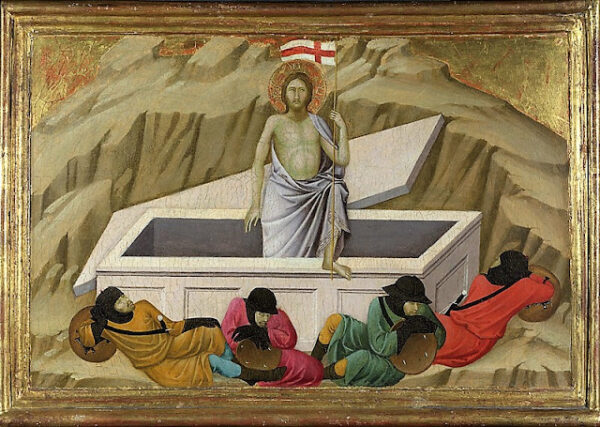
This blog post describes the evolution of an inconography in Western religious art, beginning in the twelfth century, that shows Christ emerging from the tomb. Some of these images include the women who went to the tomb, but most show the moment of Christ’s resurrection with only the guards present. There is considerable overlap in dates of different styles, but the general direction of development over the centuries was, from Christ climbing out of the tomb to Christ hovering above the tomb to Christ bursting out of the tomb.
Jesus Climbing Out of Tomb:
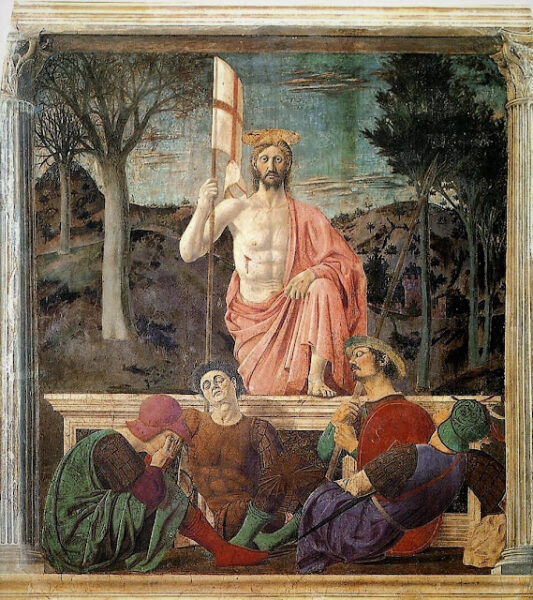
The early twelfth century resurrection depictions are illustrations of Christ, resurrected and serenely triumphant, climbing out of the tomb or standing on top of it. This iconography was fairly stable and continued throughout the Middle Ages, eventually beginning to fade away in the sixteenth century. In this iconography, Christ emerges from a sarcophagus-style tomb, while the guards are either sleeping or hiding their faces in fear. The development of these images may have been influenced by medieval drama, which portrayed complex scenes of the resurrection event that included the women at the tomb and sub-plots involving the guards. Sometimes Christ is shown with one foot on the edge of the tomb in the act of climbing out, (see Images 2 and 3) and sometimes He has already extended one leg out of the tomb (see Image 1 at top left.) This iconographic presentation, showing Jesus climbing out of the tomb, is relatviely static, giving the impression of solidity, even as it implies movement.
Christ as Standard Bearer:
In many art images of the resurrection, we see Christ holding a banner with a cross emblem, usually a red cross on a white background. This is a symbol of His victory over death on the cross. However, in an interesting parallel, there are examples of this same banner that is used in depictions of St. George slaying the dragon, a popular legend in medieval history.
During this same time frame, soldiers in the Crusades marched out to war with similar flags marked with crosses. This symbolic sign dates back to the 4th century Roman Standard of Constantine the Great. Standards were typical military equipment that allowed leaders to communicate orders to their troops, messages such as when to advance, where to regroup if they became scattered, or when to retreat, if needed.
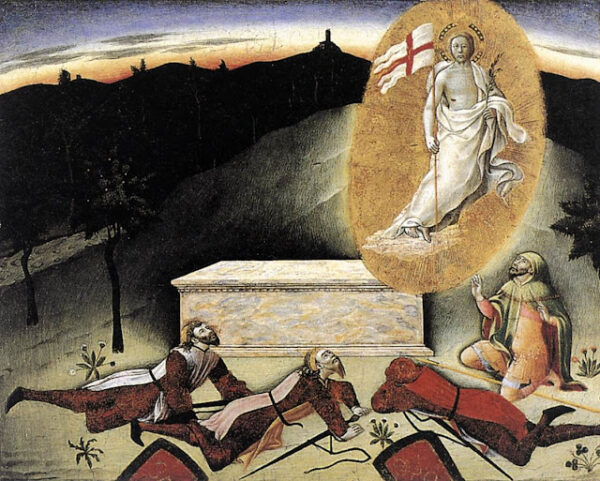
The person carrying the flag, called the standard bearer, held a position of honor and was usually unarmed, but heavily guarded. The purpose of the standard was especially important in the frenzy of battle, because it was easy to get separated from your military group. The banner made it easy to rally around – if you got lost or became overwhelmed, you could find support by moving toward the flag. Another purpose of the standard was to serve as inspiration to keep fighting.
So, while the white flag with a red cross in these paintings is a symbol of the victory of Christ over death, it is also a standard. And by viewing these standards in resurrection artwork, we can see that Jesus also inspires us by waving the banner, so that we too can turn to Christ to regroup and find community.
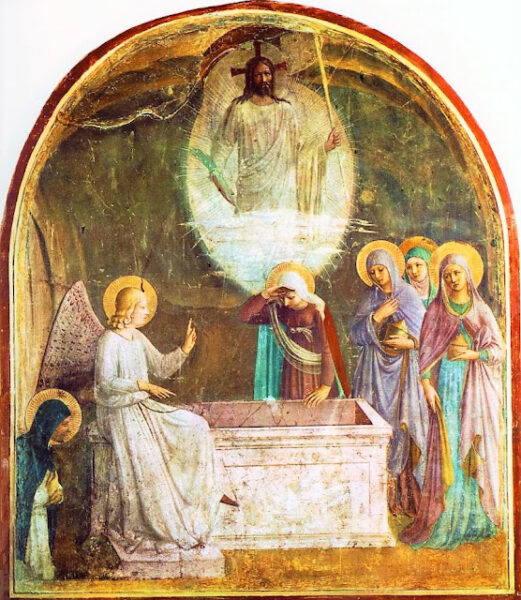
Jesus Hovering Above Tomb:
The second category of images of Christ emerging from the tomb shows Him hovering above the sarcophagus, which is sometimes open and sometimes closed. These images began to develop in the late fourteenth century and were most popular during the fifteenth and sixteenth centuries.
The resurrection iconography of Christ hovering above the tomb was a Renaissance innovation that initially developed in Italy. This progression of the style provided for more energetic imaginings of the resurrection, giving the event a more powerful depiction than the climbing out of the tomb
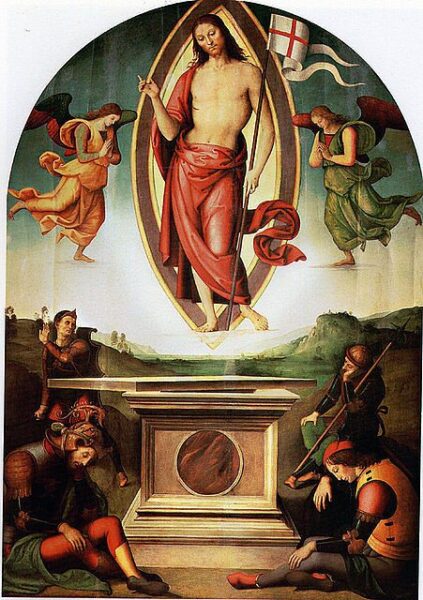
representations. Here, Christ is generally portrayed in a vertical, standing position, often surrounded by a mandorla (as in Image 6 at right) or rays of light (as in Image 4 above right.) Other images show the Risen Christ as supported by angels or floating in the air on His own.
In Image 5 by Fra Angelico above and at left, Christ appears above the tomb as the women listen to the greetings of the angel. According to Margaret Duffy of the Ad Imaginem Dei website, “the presence at the far left of the picture of a Dominican friar in prayer suggests that this image should be understood more as vision for meditation than a narrative of the actual Resurrection event.”
After 1600, the hovering Jesus is shown standing on a cloud in nearly every image, but the overall number of pictures of this type begins to diminish. By 1625, they had mostly disappeared. While the paintings of Christ hovering above the tomb have a greater intensity than those of Christ climbing out of the tomb, they still present a fairly static, devotional image of the moment of resurrection.
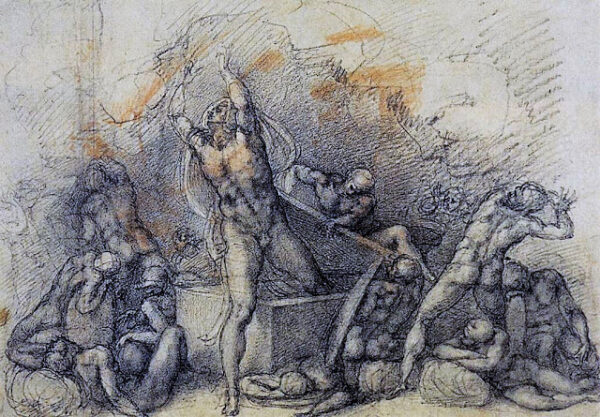
Jesus Bursting Out of Tomb:
The images of Christ hovering over the tomb pose an intermediate stage in the iconography of the resurrection that precedes later even more energetic images where Jesus is bursting out of the tomb. There is one fascinating drawing by Michelangelo that mixes the different styles and serves as a transition from climbing to hovering to bursting, shown in Image 7 at left. In his typical muscular form, Michelangelo’s drawing points the way forward to truly explosive representations of the resurrection. The intensity of this image shows Jesus vigorously stepping out of the tomb, with such energy that the guards around the tomb are actually thrown backwards.
The bursting out of the tomb iconography began to develop in the early fifteenth century, emerging in both northern and southern Europe. Here Christ literally bursts out of the tomb with an explosive blast. The bursting images are a derivation of the hovering images, but with an increased amount of animation/action. Here Jesus appears to be soaring upward, out of the tomb, although the tomb is not always still shown.
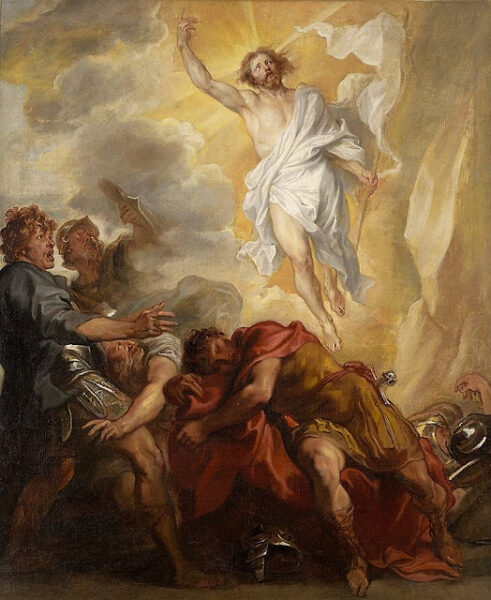
The powerful blast of energy exhibited is communicated through the position of Christ and especially by the motion of His clothing and the banner. His rapid movement is also indicated by the portrayal of his feet that are pointed downward rather than flat, as in the images of Christ climbing out of the tomb or hovering in a standing posture. In addition, the guards who surround the sarcophagus are no longer primarily asleep or turned away, but rather are in direct motion away from the event, covering their eyes against Christ’s glory.
There are of course a zillion other examples of resurrection art, even just in the 12th through the 17th century time period that is surveyed in this blog post. Hopefully this short discussion of the resurrection iconography will encourage you to go to the references below to see more of this kind of resurrection art.
UPDATE: This blog post was revised on May 29, 2024 and again on February 4, 2025 to verify links and to make minor editorial changes.
Reading: The Inclusive New Testament, Priests for Equality, Brentwood, MD, 1994.
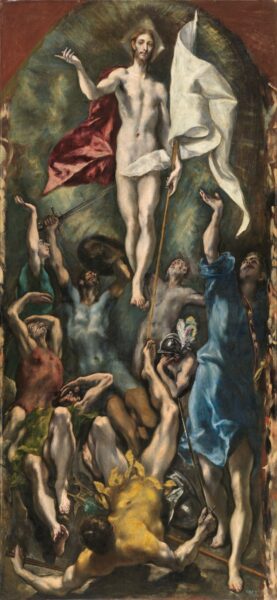
Reference 1: Duffy, Margaret, “Iconography of Resurrection – Climbing Out of the Tomb,” blog post at Ad Imaginem Dei website, May 13, 2011.
Reference 2: Duffy, Margaret, “Iconography of Resurrection – Hovering Over the Tomb,” blog post at Ad Imaginem Dei website, May 13, 2011.
Reference 3: Duffy, Margaret, “Iconography of Resurrection – Bursting from the Tomb,” blog post at Ad Imaginem Dei website, May 14, 2011.
Reference 4: https://en.wikipedia.org/wiki/Resurrection_of_Jesus_in_Christian_art
Reference 5: https://www.christianiconography.info/resurrection.html
Image 1: Christ Climbing from the Tomb, from a picture Bible at St. Omer, Abbey of St. Bertain, Koninklijk Bibliotheek, The Hague, MS KB 76 F5, fol. 21v, circa 1190-1200 CE.
Image 2: Christ Climbing from the Tomb, Ugolino di Nerio, Italian, London, National Gallery, circa 1325-1328 CE.
Image 3: Christ Climbing from the Tomb, Piero della Francesca, Italian, Sansepolcro, Pinacoteca Comunale, 1463-1465 CE.
Image 4: The Resurrection, Master of the Osservanza, Italian, Detroit Institute of Arts, circa 1440-1445 CE.
Image 5: Resurrection, the Three Women at the Tomb, Fra Angelico, Italian, Florence, Museo di San Marco, 1440-1442 CE.
Image 6: San Francesco al Prato Resurrection, Pietro Perugino, Italian, Vatican Museum, Rome, 1499-1501 CE.
Image 7: The Resurrection, Michelangelo, Italian, Windsor, Collection of Her Majesty, Queen Elizabeth II, circa 1520-1525 CE.
Image 8: Resurrection, Anthony van Dyck, Flemish, Hartford (CT), Wadsworth Athenaeum, circa 1631-1632 CE.
Image 9: El Greco, Resurrection, Greco-Spanish, Madrid, Museo Nacional del Prado, 1597-1600 CE.















Leave a Reply
Join the conversation by submitting a comment to this blog post below.